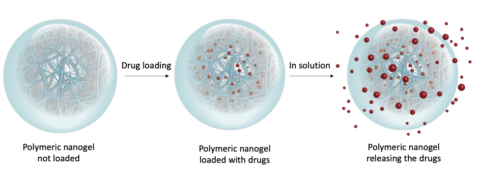Modeling of the Molecule Release Process from Polymeric Spherical Drug Carriers
Molecular communications (MC) is an emerging communications approach with many interdisciplinary applications in industry and medicine. MC can be used in environments, where classical communication using electromagnetic waves is not feasible. Applications of particular interest are infrastructure monitoring and targeted drug delivery (TDD) in the human body. In TDD, drug carriers are guided to, e.g., a tumor, where they release drug molecules. Particularly, the drug is delivered where the medicine is needed while drug toxicity and wastage are reduced compared to classical approaches. Under the MC paradigm, two aspects of TDD have been mostly investigated, i.e., the targeting process and the controlled drug release.
Based on preliminary work, the focus of this thesis lies in the modeling and analysis of the drug release process from spherical drug carriers. In particular, homogeneous and heterogeneous matrix systems shall be investigated as they are suitable mathematical abstractions of different polymeric or silica nanoparticle drug carriers.
Tasks:
- Review of existing drug release concepts: Based on preliminary work, existing models for the release from homogeneous and heterogeneous matrix systems shall be reviewed, analyzed and compared to each other.
- Release from heterogeneous systems: Existing models for the heterogeneous release mostly rely on a modification of simple models for the homogeneous release. Another approach is to investigate diffusion in porous media based on the fractional diffusion equation. Hence, this approach shall be investigated whether it is suitable to model the release process from heterogeneous matrix systems.
-
Adaption to realistic parameters: To demonstrate the usefulness of the established models, they shall be evaluated and analyzed with realistic parameter values obtained from the chemical literature and/or measurements.
-
Embedding into the MC framework: The established models shall be incorporated into a simple TDD scenario with the matrix system acting as transmitter and an absorbing receiver representing a diseased cell or its nucleus.

